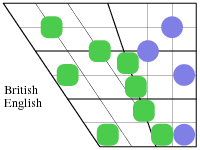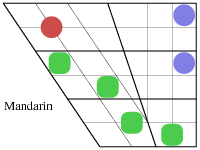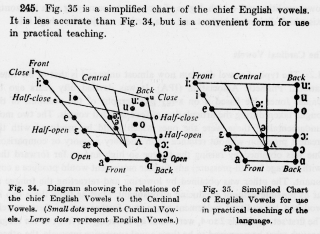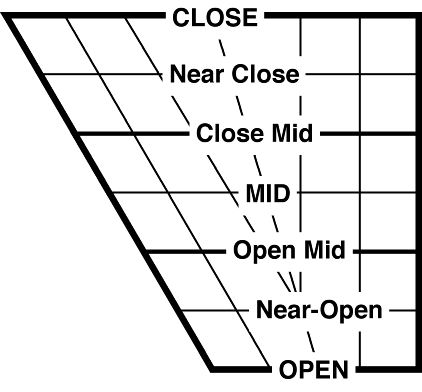
Fig. 1

Fig. 2

Fig. 3

Fig. 4

Fig. 5

Fig. 6
My first memory of becoming aware of the work of Professor Lee was when I opened my copy of the July 1968 issue of Le Maître Phonétique (the precursor of the Journal of the International Phonetic Association) to find that its leading article at pages 26 to 29 was his very modestly entitled — but on reading found to be rather startling — 'A Remark on the IPA Cardinal Back Vowels'. This made the, at that time to many, disturbing suggestion that there were actually backer vowels than those that Daniel Jones had said were the backest.
It began "The value of the IPA Cardinal Vowel system as an accurate and useful device for measuring vowel sounds in phonetics has been accepted so well and so long that it seems hardly necessary for me to say anything more about it. However, the usefulness of a certain scheme in its actual application is one thing, and the validity of the definition on which such a scheme is based and operates is quite another". He went on to quote the eighth edition of the Jones Outline of English Phonetics §126 "It is from among these vowels which are as remote as possible from the ‘neutral’ position that it has been found convenient to select the ‘Cardinal Vowels’...". He added that '...it amounts to saying that any vowel of any language can be indicated on or inside the quadrilateral but not outside [and] that the Cardinal back vowels are the most extreme back vowels humanly pronounceable ... etc". He had had meeting on the topic with Daniel Jones who in the course of their discussion had confirmed that he felt that this declaration of 1956 still fully stood.
Actually, Lee had formed the opinion that in the pronunciation of some Koreans there were four back vowels that were all more back in their qualities than the four nearest Cardinals. In order to ascertain how far his auditory judgments might be confirmed he undertook spectrographic analyses of the Korean vowels in question. He was able to produce comparative tables of their first and second formants. The first table gave the values for the four Cardinal back vowels [ɑ, ɔ, o, u] uttered by himself in practically identical imitation of Jones's recordings and the second table was of corresponding vowels produced by "modifying [the tongue posture] backward from each Cardinal position". Jones's auditory judgment of Lee's retracted versions was that they, especially [ɔ] and [o], were 'somewhat lower or opener' than the corresponding Cardinals. An accompanying comparative 'acoustic chart' that Lee provided seemed to suggest that, whatever might have been the somewhat uncertain particular tongue adjustments involved, the relative plottings of the vowel formants corresponded well to what might be associated with the possibility of further retraction of the tongue.
I was intrigued by these findings especially because they seemed to contribute to the confirmation of my increasing doubts about just how appropriate the Jones system was in respect of the identification of highly precise vowel values. It was one of various things which contributed to these uncertainties. I had and still have have firm faith in the great usefulness of the system in its provision of a simple but precisely specified diagram for certain practical applications. It's an excellent means of displaying with very satisfying adequacy the contrasts involved in the systems of the vowel phonemes of most languages. It also provides an extremely effective way of displaying side by side the contrasts between one language and practically any other. Again it's especially valuable in language teaching to show the learner's values beside those of a target language. I have demonstrated my faith in the diagram's usefulness at §9.2 of my Website (www.yek.me.uk) where 132 examples of attempts to show the vowel systems of a wide variety of languages from all over the world may be seen.
 Fig. 1 |
 Fig. 2 |
 Fig. 3 |
 Fig. 4 |
 Fig. 5 |
 Fig. 6 |
The version of the diagram used there is a slight adaptation involving three horizontal and five vertical relatively faint additional guidelines for the eye. The vowel indicators employed are all of a size specified as approximately one-thirtieth of the total area of the diagram. Each of them is circular in shape if any degree of lip-rounding is involved and square if that is not so. All are centred either upon one of the lines of the grid or of one or other of the square or quadrilateral divisions of the diagram. Each vowel indicator is one the four colours green, blue, red and yellow (with a minor exception) according to whether it is respectively front-unrounded, back-rounded, front-rounded or back-unrounded. The purpose of the grid is to convey that the placings are schematic and symbolic and to let it be understood that it was judged that more delicate positionings or indicators of smaller sizes would undesirably suggest what should be considered inappropriate not to say spurious precision.
My misgivings with regard to the Cardinal Vowels system do not apply to its practical uses of the types I have mentioned but to its appropriateness when it comes to specifying very precise vowel qualities. The more I observe the variabilities in the ways speakers employ their vocalic phonemes the more I feel unable to accept that specifications for phonemes should go beyond the degree of precision that can be for most items conveniently represented by a chart of the simplicity described above. The 'pinhead' dots (as small as one three hundredth of the area of the chart or even smaller) that some users of the IPA diagram still employ, for example in the latest editions of Jones's (now called by its publishers "The Cambridge") English Pronouncing Dictionary, to indicate phonemes seem to me to involve undesirably inappropriate implications.
Jones himself relaxed quite notably in the course of his long career in respect of the sizes of his vowel indicators. In his earliest diagrams the vowel indicators of the largest types he used were so small that that they occupied no more than about that one three-hundredth of the total area of the diagram. By the time he designed his last ones they were much more than twice his previous maximum sizes. Other evidence of his increasing cautiousness in respect of the doubtfully justified precision adopted in representing vowels on diagrams was his use of progressively simpler more regularised outlines for those diagrams. Beginning with trapezoids, he progressively straightened their backs and converted them to trapeziums i.e. with tops and bottoms horizontal and parallel.

Fig. 7. Jones Outline 1932-1956
A striking revelation came in 1932 at his Outline §245 when he published the most thoroughgoing of all the revisions of his Outline. There he introduced for the first time his most drastically simplified of all his versions of his Cardinal Vowels diagram. It is of course very significant that this very form has now actually became the only shape authorised by the International Phonetic Association with the publication of its important Handbook of 1999. Actually, Jones really only explicitly sanctioned this trapezium for use as a 'Simplified Chart of English Vowels for use in practical teaching of the language'. Various of the adustments it revealed him as willing to accept as teaching targets were quite surprisingly drastic. For example he moved /ᴧ/ from 'Half-open' (now called 'Open Mid') Near-Back to completely Central. He made several other similarly considerable moves.
 Fig. 8 |
 Fig. 9 |
During the period in which Hyun-Bok Lee was preparing his paper another researcher was finalising his assembly of what amounted to a very extensive and penetrating critique of the physiology-based approach to the analysis and description vowels — to what in fact can be said to have culminated in Daniel Jones's setting up of his Cardinal Vowels system. This other researcher was Peter Ladefoged (1925-2006) who finally published his findings in a major article summarising what had been in fact largely his work for his doctoral degree. This article was the 92-page centrepiece on 'The Nature of Vowel Quality' of his 1967 book entitled Three Areas of Experimental Phonetics. Its companion articles together occupied much less space than the main one did but the final one, which was of about thirty pages, was concerned with very much the same essential topic as the central one.
Since the publication of Hyun-Bok Lee's article his findings have remained unchallenged to the best of my knowledge and Daniel Jones never enlarged upon his initial comments. In the far-off days when our present universal easy access to high-quality recording and playback equipment was merely a dream of the future it was understandably felt to be enormously valuable to communicate on paper relatively precise information with respect to vowels and other sounds. This is now no longer felt to be such a vital necessity.
Although Ladefoged's extensive work had mounted the most cogent and complete undermining of reliance on the assumptions on which Jones had based his Cardinal Vowels scheme which, incidentally, he had developed from a basis invented by Alexander Melville Bell (1890-1905) and accepted by Jones's mentor Paul Passy (1859-1940), it was by no means the first. Ladefoged quotes the forceful comment of the very important American researcher George Oscar Russell (1890-1962) who, in one or other of his two 1928 publications both titled (initially but with diffferent extensions) The Vowel, remarked that "phoneticians are thinking in terms of acoustic fact and using physiological fantasy to express the idea". In the circumstances there is no argument but that Hyun-Bok Lee's "Remark" was to be taken very seriously. Indeed it is to be considered as a valuable early corroboration in a location not then pursued by other researchers, of the scientific dubiousness of the basis of Jones's system of vowel classification.